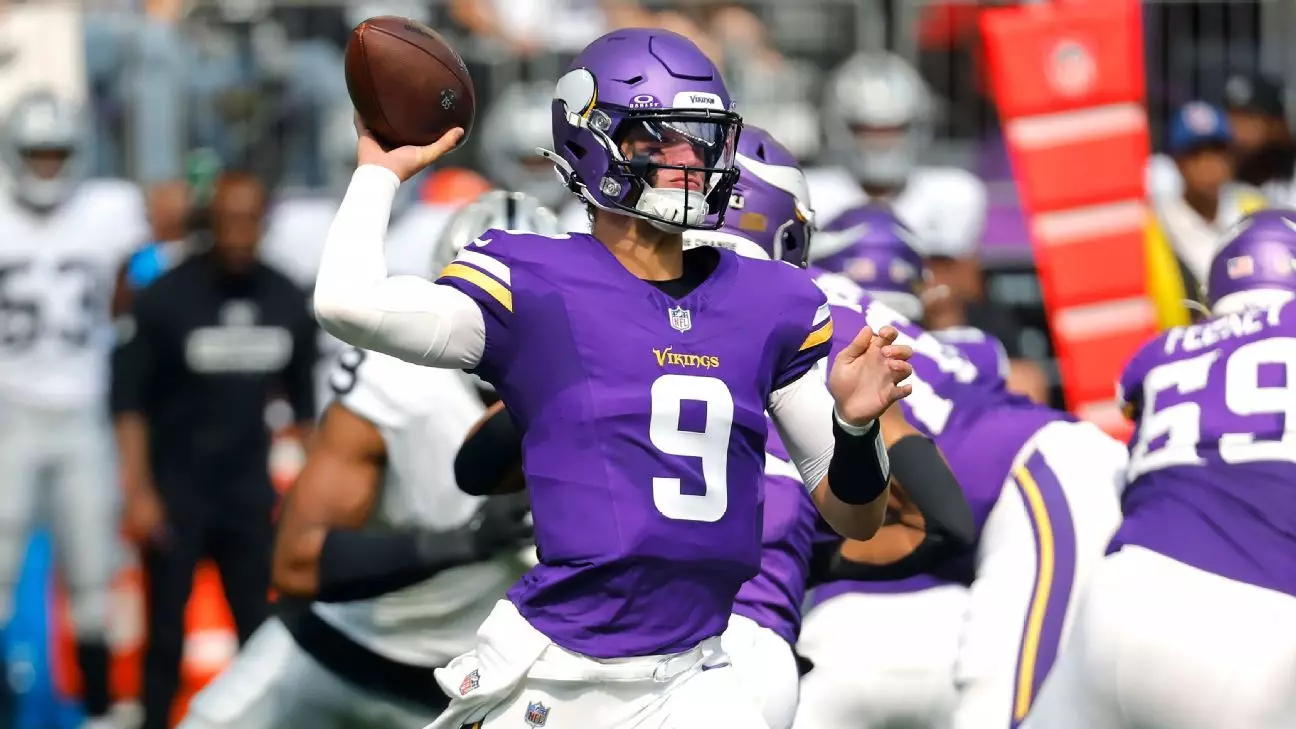The Minnesota Vikings are embarking on a significant transition in their quarterback hierarchy as they turn their attention away from the pursuit of Aaron Rodgers. This decision not only highlights the organization’s commitment to second-year quarterback J.J. McCarthy but also marks a shift in strategy that could define the franchise for years to come. With offseason practices around the corner, McCarthy has secured the top position in the Vikings’ depth chart, and the implications of this change resonate deeply within the team’s future prospects.
McCarthy, who suffered a major setback last season with a torn meniscus, is determined to claim his status as a leading quarterback in the league. After undergoing surgery in August, McCarthy’s presence—despite missing his rookie season—provides a unique opportunity for the Vikings to develop him into a franchise cornerstone. The reluctance to bring in a seasoned player like Rodgers, despite his Hall of Fame credentials, suggests that the Vikings are prioritizing McCarthy’s growth over short-term gains.
The Fallout from Free-Agent Movements
The Vikings spent considerable time deliberating their quarterback options, particularly after other teams made moves that reshaped the landscape. With Sam Darnold heading to the Seattle Seahawks and Daniel Jones opting for a contract with the Indianapolis Colts, the Vikings found themselves in a challenging position. Rather than scrambling to secure a veteran backup, they’ve taken a calculated risk, opting to focus on nurturing McCarthy’s abilities.
This strategy has not emerged without due consideration. Reports indicate that McCarthy has garnered trade interest from other NFL teams, yet the Vikings appear resolute in keeping him. This is a clear indication of how they envision the trajectory for their roster; they want to build around a young quarterback rather than depending on aging veterans. It reflects a modern approach to team building—favoring development and potential over experience and marketability.
The Vikings’ Commitment to Youth and Development
The organization’s decision to forgo the franchise tag on Darnold further reinforces their commitment to McCarthy. By investing over $300 million in free agency to bolster the roster, the Vikings are signaling their belief that a young quarterback can lead them to success. The absence of a high-profile signing to sit behind McCarthy positions him as not just the future, but the immediate focus in the Vikings’ quest for sustained excellence.
Head coach Kevin O’Connell’s steadfast support of McCarthy has raised expectations. Calling him “our franchise quarterback” signals a belief in McCarthy’s ability to not only adapt but thrive in a competitive environment. This endorsement sets the stage for McCarthy to take ownership of the team as it prepares for challenges ahead.
While there is caution surrounding the young quarterback, given the injury risks and developmental needs he faces, the Vikings are prepared to pivot should he falter. They’ve kept the door ajar for potential discussions with Rodgers should circumstances necessitate revisiting this option. However, most indicators suggest that the front office is strongly intent on seeing McCarthy through this phase of his career.
The Search for Backup Stability
While their primary investment is in McCarthy, the Vikings must remain vigilant in securing a competent backup. With current options limited to Brett Rypien, the urgency to seek a reliable veteran becomes imperative as training camp approaches. Candidates like Joe Flacco and Carson Wentz have emerged as possible signings, providing the franchise with the reliability they might lack in depth. Furthermore, the prospect of bringing back Kirk Cousins—now a backup with the Atlanta Falcons—adds another layer of intrigue to their backup situation.
Ultimately, the offseason has revealed the Vikings’ strategic approach: a commitment to youth, a willingness to embrace risk, and a readiness to invest resources in shaping a competitive future. All while navigating the complexities of the NFL landscape, the organization’s choices reflect a desire not just to compete but to innovate, relying on the potential of their young quarterback as they set their sights on the upcoming season. The Vikings may just be setting the groundwork for a new football narrative in Minnesota, one built around the promise and potential of J.J. McCarthy.


Leave a Reply